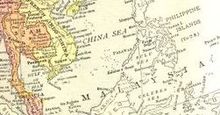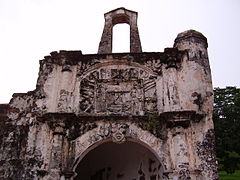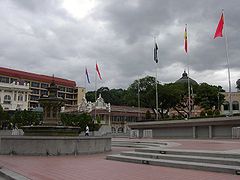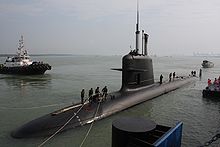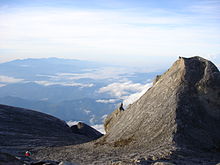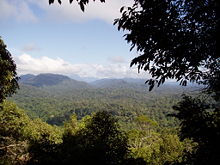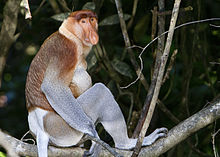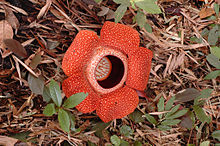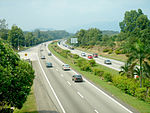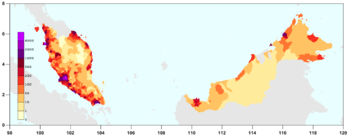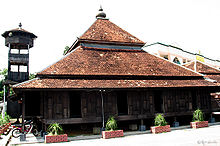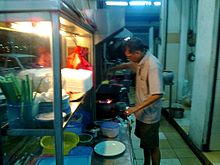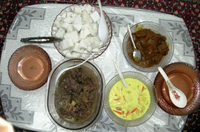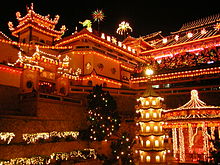
Malaysia
Did you know...
This Wikipedia selection is available offline from SOS Children for distribution in the developing world. Do you want to know about sponsoring? See www.sponsorachild.org.uk
| Malaysia | ||||||
|---|---|---|---|---|---|---|
|
||||||
| Motto: "Bersekutu Bertambah Mutu" "Unity Is Strength" |
||||||
| Anthem: Negaraku My Country (instrumental) |
||||||
|
|
||||||
| Capital and largest city |
Kuala Lumpur Putrajaya (administrative) 3°08′N 101°42′E |
|||||
| Official languages | Malaysian | |||||
| Official script | Malay (Latin) alphabet | |||||
| Recognized | English | |||||
| Ethnic groups () |
|
|||||
| Demonym | Malaysian | |||||
| Government | Federal constitutional elective monarchy and federal parliamentary democracy | |||||
| - | King | Abdul Halim | ||||
| - | Prime Minister | Najib Tun Razak ( BN) | ||||
| - | Deputy Prime Minister | Muhyiddin Yassin ( BN) | ||||
| Legislature | Parliament | |||||
| - | Upper house | Dewan Negara | ||||
| - | Lower house | Dewan Rakyat | ||||
| Independence from the United Kingdom | ||||||
| - | 31 August 1957 | |||||
| - | 22 July 1963 | |||||
| - | 31 August 1963 | |||||
| - | Federation of Malaya, North Borneo, Sarawak, Singapore |
16 September 1963 | ||||
| Area | ||||||
| - | Total | 329,847 km2 ( 67th) 127,355 sq mi |
||||
| - | Water (%) | 0.3 | ||||
| Population | ||||||
| - | 2010 census | 28,334,135 ( 42nd) | ||||
| - | Density | 86/km2 ( 114th) 216.45/sq mi |
||||
| GDP ( PPP) | 2012 estimate | |||||
| - | Total | $491.967 billion | ||||
| - | Per capita | $16,942 | ||||
| GDP (nominal) | 2012 estimate | |||||
| - | Total | $307.178 billion | ||||
| - | Per capita | $10,578 | ||||
| Gini (2009) | 46.2 high · 36th |
|||||
| HDI (2013) | high · 64th |
|||||
| Currency | Ringgit (RM) ( MYR) |
|||||
| Time zone | MST ( UTC+8) | |||||
| - | Summer ( DST) | not observed ( UTC+8) | ||||
| Date format | dd-mm-yyyy | |||||
| Drives on the | left | |||||
| Calling code | +60 | |||||
| ISO 3166 code | MY | |||||
| Internet TLD | .my | |||||
| a. | ^ Kuala Lumpur is the capital city and is home to the legislative branch of the Federal government. Putrajaya is the primary seat of the federal government where the executive and judicial branches are located. | |||||
| b. | ^ The terminology as per government policy is Bahasa Malaysia (literally "Malaysian language") but legislation continues to refer to the official language as Bahasa Melayu (literally "Malay language"). | |||||
| c. | ^ Under the National Language Act 1967, "The script of the national language shall be the Rumi [Latin] script: provided that this shall not prohibit the use of the Malay script, more commonly known as the Jawi script, of the national language." | |||||
| d. | ^ Under the National Language Act 1967, English may be used for some purposes. | |||||
| e. | ^ Before the accession, Sabah was referred to as North Borneo. | |||||
| f. | ^ Singapore became an independent country on 9 August 1965. | |||||
Malaysia ( / m ə ˈ l eɪ ʒ ə / mə-LAY-zhə or / m ə ˈ l eɪ s i ə / mə-LAY-see-ə) is a federal constitutional monarchy in Southeast Asia. It consists of thirteen states and three federal territories and has a total landmass of 329,847 square kilometres (127,350 sq mi) separated by the South China Sea into two similarly sized regions, Peninsular Malaysia and Malaysian Borneo. Land borders are shared with Thailand, Indonesia, and Brunei, and maritime borders exist with Singapore, Vietnam, and the Philippines. The capital city is Kuala Lumpur, while Putrajaya is the seat of the federal government. In 2010 the population was 28.33 million, with 22.6 million living on the Peninsula.
Malaysia has its origins in the Malay Kingdoms present in the area which, from the 18th century, became subject to the British Empire. The first British territories were known as the Straits Settlements, whose establishment was followed by the Malay kingdoms becoming British protectorates. The territories on Peninsular Malaysia were first unified as the Malayan Union in 1946. Malaya was restructured as the Federation of Malaya in 1948, and achieved independence on 31 August 1957. Malaya united with Sabah, Sarawak, and Singapore on 16 September 1963, with si being added to give the new country the name Malaysia. Less than two years later in 1965, Singapore was expelled from the federation. Since independence, Malaysia has had one of the best economic records in Asia, with GDP growing an average 6.5% for almost 50 years. The economy has traditionally been fuelled by its natural resources, but is expanding in the sectors of science, tourism, commerce and medical tourism.
The country is multi-ethnic and multi-cultural, which plays a large role in politics. The constitution declares Islam the state religion while protecting freedom of religion. The government system is closely modelled on the Westminster parliamentary system and the legal system is based on English Common Law. The head of state is the King, known as the Yang di-Pertuan Agong. He is an elected monarch chosen from the hereditary rulers of the nine Malay states every five years. The head of government is the Prime Minister.
Malaysia contains the southernmost point of continental Eurasia, Tanjung Piai. Located in the tropics, it is a megadiverse country, with large numbers of endemic animals, fungi and plants. It is a founding member of the Association of Southeast Asian Nations, the East Asia Summit and the Organisation of Islamic Cooperation, and a member of Asia-Pacific Economic Cooperation, the Commonwealth of Nations, and the Non-Aligned Movement.
Etymology
The word Melayu is thought to derive from the Tamil words Malai and ur meaning "mountain" and "city, land", respectively. The term was later used as the name of the Melayu Kingdom, which existed between the 7th and 13th centuries on Sumatra. Malayadvipa was the word used by ancient Indian traders when referring to the Malay Peninsula.
Following his 1826 expedition in Oceania, French navigator Jules Dumont d'Urville invented the terms Malaysia, Micronesia and Melanesia, distinguishing these Pacific cultures and island groups from the existing term Polynesia. In 1831, he proposed these terms to the Société de Géographie. Dumont d'Urville described Malaysia as "an area commonly known as the East Indies". In 1850, the English ethnologist George Samuel Windsor Earl, writing in the Journal of the Indian Archipelago and Eastern Asia, proposed naming the islands of Southeast Asia as Melayunesia or Indunesia, favouring the former.
In 1957, the Federation of Malaya was declared as an independent federation of the Malay states on the Malay Peninsula. The name "Malaysia" was adopted in 1963 when the existing states of the Federation of Malaya, plus Singapore, North Borneo and Sarawak formed a new federation, with "sia" being added to Malaya in honour of the three joining states. Prior to that, the name itself had been used to refer to the whole Malay Archipelago. Politicians in the Philippines contemplated renaming their state "Malaysia" before the modern country took the name. At the time of federation, other names were considered: among them was Langkasuka, after the historic kingdom located at the upper section of the Malay Peninsula in the 1st millennium CE.
History
Evidence of modern human habitation in Malaysia dates back 40,000 years. The first inhabitants are thought to be Negritos. Traders and settlers from India and China arrived as early as the 1st century AD, establishing trading ports and coastal towns in the 2nd and 3rd centuries. Their presence resulted in strong Indian and Chinese influence on the local cultures, and the people of the Malay Peninsula adopted the religions of Hinduism and Buddhism. Sanskrit inscriptions appear as early as the 4th or 5th century. The Kingdom of Langkasuka arose around the 2nd century in the northern area of the Malay Peninsula, lasting until about the 15th century. Between the 7th and 13th centuries, much of the southern Malay Peninsula was part of the maritime Srivijaya empire. After the fall of Srivijaya, the Majapahit empire had influence over most of Peninsular Malaysia and the Malay Archipelago. Islam began to spread among Malays in the 14th century. In the early 15th century, Parameswara, a prince of the former Srivijayan empire, founded the Malacca Sultanate, commonly considered the first independent state in the peninsula. Malacca was an important commercial centre during this time, attracting trade from around the region. Parameswara became a Muslim, accelerating the spread of Islam.
In 1511 Malacca was conquered by Portugal, after which it was taken by the Dutch in 1641. In 1786 the British Empire established a presence in Malaya, when the Sultan of Kedah leased Penang to the British East India Company. The British obtained the town of Singapore in 1819, and in 1824 took control of Malacca following the Anglo-Dutch Treaty. By 1826 the British directly controlled Penang, Malacca, Singapore, and the island of Labuan, which they established as the crown colony of the Straits Settlements. By the 20th century, the states of Pahang, Selangor, Perak, and Negeri Sembilan, known together as the Federated Malay States, had British Residents appointed to advise the Malay rulers, to whom the rulers were bound to defer by treaty. The remaining five states in the peninsula, known as the Unfederated Malay States, while not directly under British rule, also accepted British advisers around the turn of the 20th century. Development on the Peninsula and Borneo were generally separate until the 19th century. Under British rule the immigration of Chinese and Indians to serve as labourers was encouraged. Sabah was governed as the crown colony of British North Borneo after the Sultanate of Sulu transferred all his right in 1878. In 1842, Sarawak was ceded by the Sultan of Brunei to James Brooke, whose successors ruled as the White Rajahs over an independent kingdom until 1946, when it became a Crown colony.
In the Second World War the Japanese army invaded and occupied Malaya, Sabah, Sarawak, and Singapore for over three years. During this time, ethnic tensions were raised and nationalism grew. Popular support for independence increased after Malaya was reconquered by Allied Forces. Post-war British plans to unite the administration of Malaya under a single crown colony called the Malayan Union met with strong opposition from the Malays, who opposed the weakening of the Malay rulers and the granting of citizenship to the ethnic Chinese. The Malayan Union, established in 1946 and consisting of all the British possessions in the Malay Peninsula with the exception of Singapore, was quickly dissolved and replaced by the Federation of Malaya, which restored the autonomy of the rulers of the Malay states under British protection. During this time, mostly Chinese rebels under the leadership of the Malayan Communist Party launched guerrilla operations designed to force the British out of Malaya. The Malayan Emergency lasted from 1948 to 1960, and involved a long anti-insurgency campaign by Commonwealth troops in Malaya. After this a plan was put in place to federate Malaya with the British crown colonies of Sabah, Sarawak, and Singapore. The proposed date of federation was 31 August 1963, however, the date was delayed until 16 September 1963 due to opposition from Indonesia's Sukarno and the Sarawak United Peoples' Party.
Federation brought heightened tensions including a conflict with Indonesia, Singapore's eventual exit in 1965, and racial strife. This strife culminated in the 13 May race riots in 1969. After the riots, the controversial New Economic Policy was launched by Prime Minister Tun Abdul Razak, trying to increase the share of the economy held by the bumiputera. Under Prime Minister Mahathir Mohamad there was a period of rapid economic growth and urbanisation beginning in the 1980s. The economy shifted from being agriculturally based to one based on manufacturing and industry. Numerous mega-projects were completed, such as the Petronas Towers, the North-South Expressway, the Multimedia Super Corridor, and the new federal administrative capital of Putrajaya. However, in the late 1990s the Asian financial crisis almost caused the collapse of the currency and the stock and property markets.
Government and politics
Malaysia is a federal constitutional elective monarchy. The system of government is closely modelled on that of the Westminster parliamentary system, a legacy of British colonial rule. The head of state is the Yang di-Pertuan Agong, commonly referred to as the king. The King is elected to a five-year term by and from among the nine hereditary rulers of the Malay states; the other four states, which have titular Governors, do not participate in the selection. By informal agreement the position is systematically rotated among the nine, and has been held by Abdul Halim of Kedah since December 2011. The King's role has been largely ceremonial since changes to the constitution in 1994, picking ministers and members of the upper house.
Legislative power is divided between federal and state legislatures. The bicameral federal parliament consists of the lower house, the House of Representatives and the upper house, the Senate. The 222-member House of Representatives is elected for a maximum term of five years from single-member constituencies. All 70 senators sit for three-year terms; 26 are elected by the 13 state assemblies, and the remaining 44 are appointed by the King upon the Prime Minister's recommendation. The parliament follows a multi-party system and the government is elected through a first-past-the-post system. Since independence Malaysia has been governed by a multi-party coalition known as the Barisan Nasional.
Each state has a unicameral State Legislative Assembly whose members are elected from single-member constituencies. State governments are led by Chief Ministers, who are state assembly members from the majority party in the assembly. In each of the states with a hereditary ruler, the Chief Minister is required to be a Malay, appointed by the ruler upon the recommendation of the Prime Minister. Parliamentary elections are held at least once every five years, the most recent of which took place in March 2008. Registered voters of age 21 and above may vote for the members of the House of Representatives and, in most of the states, for the state legislative chamber. Voting is not mandatory. Except for elections in Sarawak, all state elections are held concurrently with the federal election.
Executive power is vested in the Cabinet, led by the Prime Minister. The prime minister must be a member of the house of representatives, who in the opinion of the King, commands a majority in parliament. The cabinet is chosen from members of both houses of Parliament. The Prime Minister is both the head of cabinet and the head of government. The incumbent, Najib Razak, appointed in 2009, is the sixth prime minister.
Malaysia's legal system is based on English Common Law. Although the judiciary is theoretically independent, its independence has been called into question and the appointment of judges lacks accountability and transparency. The highest court in the judicial system is the Federal Court, followed by the Court of Appeal and two high courts, one for Peninsular Malaysia and one for East Malaysia. Malaysia also has a special court to hear cases brought by or against Royalty. Separate from the civil courts are the Syariah Courts, which apply Shariah law to cases which involve Malaysian Muslims and run parallel to the secular court system. The Internal Security Act allows detention without trial, and the death penalty is in use for crimes such as drug trafficking.
Race is a significant force in politics, and many political parties are ethnically based. Actions such as the New Economic Policy and the National Development Policy which superseded it, were implemented to advance the standing of the bumiputera, consisting of Malays and the indigenous tribes who are considered the original inhabitants of Malaysia, over non-bumiputera such as Malaysian Chinese and Malaysian Indians. These policies provide preferential treatment to bumiputera in employment, education, scholarships, business, and access to cheaper housing and assisted savings. However, it has generated greater interethnic resentment. There is ongoing debate over whether the laws and society of Malaysia should reflect secular or Islamic principles. Islamic laws passed by the Pan-Malaysian Islamic Party in state legislative assemblies have been blocked by the federal government.
Foreign relations and military
A founding member of the Association of Southeast Asian Nations (ASEAN) and the Organisation of Islamic Cooperation (OIC), the country participates in many international organisations such as the United Nations, the Asia-Pacific Economic Cooperation, the Developing 8 Countries, and the Non-Aligned Movement (NAM). It has chaired ASEAN, the OIC, and the NAM in the past. A former British colony, it is also a member of the Commonwealth of Nations. Kuala Lumpur was the site of the first East Asia Summit in 2005.
Malaysia's foreign policy is officially based on the principle of neutrality and maintaining peaceful relations with all countries, regardless of their political system. The government attaches a high priority to the security and stability of Southeast Asia, and seeks to further develop relations with other countries in the region. Historically the government has tried to portray Malaysia as a progressive Islamic nation while strengthening relations with other Islamic states. A strong tenet of Malaysia's policy is national sovereignty and the right of a country to control its domestic affairs.
The policy towards territorial disputes by the government is one of pragmatism, with the government solving disputes in a number of ways, such as bringing the case to the International Court of Justice. The Spratly Islands are disputed by many states in the area, although tensions have eased since the 2002 Declaration on the Conduct of Parties in the South China Sea. Brunei and Malaysia in 2008 announced an end to claims of each other's land, and to resolve issues related to their maritime borders. The Philippines has a dormant claim to Sabah. Singapore's land reclamation has caused tensions, and maritime border disputes exist with Indonesia.
Malaysia has never recognised Israel and has no diplomatic ties with it. It has remained a strong supporter of the State of Palestine, and has called for Israel to be taken to the International Criminal Court over the Gaza flotilla raid. Malaysian peacekeeping forces are present in Lebanon and have contributed to many other UN peacekeeping missions.
The Malaysian Armed Forces have three branches, the Royal Malaysian Navy, the Malaysian Army, and the Royal Malaysian Air Force. There is no conscription, and the required age for voluntary military service is 18. The military uses 1.9 per cent of the country's GDP, and employs 1.23 per cent of Malaysia's manpower. Currently, Malaysia is undergoing major program to expand and modernize all three branches of its armed forces.
The Five Power Defence Arrangements is a regional security initiative which has been in place for almost 40 years. It involves joint military exercises held among Malaysia, Singapore, Australia, New Zealand, and the United Kingdom. Joint exercises and war games have been held with Indonesia for years. Malaysia and the Philippines have agreed to host joint security force exercises in order to secure their maritime border and tackle issues such as illegal immigration. There are fears that unrest in the Muslim areas of the southern Philippines and southern Thailand could spill over into Malaysia.
Subdivisions
 Perlis
Kedah
Penang
Kelantan
Terengganu
Perak
Selangor
Negeri Sembilan
Malacca
Johor
Pahang
Sarawak
Sabah
Labuan
Putrajaya
West Malaysia
East Malaysia
Federal Territory
Gulf of Thailand
Sulu Sea
Celebes Sea
|
Malaysia is a federation of 13 states and three federal territories. These are divided between two regions, with 11 states and two federal territories on Peninsular Malaysia and the other two states and one federal territory in East Malaysia. Governance of the states is divided between the federal and the state governments, and the Federal government has direct administration of the federal territories.
The 13 states are based on historical Malay Kingdoms, and 9 of the 11 Peninsular states, known as the Malay states, retain their royal families. The King is elected by and from the nine rulers to serve a five-year term. Each state has a unicameral legislature known as the State Legislative Assembly. The states of East Malaysia ( Sabah and Sarawak) have separate immigration policies and controls, and a unique residency status. For citizens of one of these states or Peninsular Malaysia, the other areas of Malaysia are considered foreign countries under immigration laws. Each state is further divided into districts, which are then divided into mukim. In Sabah and Sarawak districts are grouped into divisions.
The federal parliament is permitted to legislate on issues of land, the Islamic religion and local government, in order to provide for a uniform law among all states. It may also intervene at the request of the state assembly concerned. Except for some land related laws, the in question must also be passed by the state assembly. Non-Islamic issues that fall under the purview of the state may also be legislated at the federal level for the purpose of conforming with Malaysian treaty obligations.
Geography
Malaysia is the 67th largest country by total land area, with a land area of 329,847 km2 (127,355 sq mi). It has land borders with Thailand in West Malaysia, and Indonesia and Brunei in East Malaysia. It is linked to Singapore by a narrow causeway and a bridge. The country also has maritime boundaries with Vietnam and the Philippines. The land borders are defined in large part by geological features such as the Perlis River, the Golok River and the Pagalayan Canal, whilst some of the maritime boundaries are the subject of ongoing contention. Brunei forms what is almost an enclave in Malaysia, with the state of Sarawak dividing it into two parts. Malaysia is the only country with territory on both the Asian mainland and the Malay archipelago. Tanjung Piai, located in the southern state of Johor, is the southernmost tip of continental Asia. The Strait of Malacca, lying between Sumatra and Peninsular Malaysia, is one of the most important thoroughfares in global commerce, carrying 40 per cent of the world's trade.
The two parts of Malaysia, separated from each other by the South China Sea, share a largely similar landscape in that both Peninsular and East Malaysia feature coastal plains rising to hills and mountains. Peninsular Malaysia, containing 40 per cent of Malaysia's land area, extends 740 km (460 mi) from north to south, and its maximum width is 322 km (200 mi). It is divided between its east and west coasts by the Titiwangsa Mountains, part of a series of mountain ranges running down the centre of the peninsula. These mountains are heavily forested, and mainly composed of granite and other igneous rocks. Much of it has been eroded, creating a karst landscape. The range is the origin of some of Peninsular Malaysia's river systems. The coastal plains surrounding the peninsula reach a maximum width of 50 kilometres (31 mi), and the peninsula's coastline is nearly 1,931 km (1,200 mi) long, although harbours are only available on the western side.
East Malaysia, on the island of Borneo, has a coastline of 2,607 km (1,620 mi). It is divided between coastal regions, hills and valleys, and a mountainous interior. The Crocker Range extends northwards from Sarawak, dividing the state of Sabah. It is the location of the 4,095.2 m (13,436 ft) high Mount Kinabalu, the tallest mountain in Malaysia. Mount Kinabalu is protected as the Kinabalu National Park, a UNESCO World Heritage Site. The highest mountain ranges form the border between Malaysia and Indonesia. Sarawak contains the Mulu Caves, the largest cave system in the world.
Around these two halves of Malaysia are numerous islands, the largest of which is Banggi. The local climate is equatorial and characterised by the annual southwest (April to October) and northeast (October to February) monsoons. The temperature is moderated by the presence of the surrounding oceans. Humidity is usually high, and the average annual rainfall is 250 cm (98 in). The climates of the Peninsula and the East differ, as the climate on the peninsula is directly affected by wind from the mainland, as opposed to the more maritime weather of the East. Local climates can be divided into three regions, highland, lowland, and coastal. Climate change is likely to affect sea levels and rainfall, increasing flood risks and leading to droughts.
Biodiversity
Malaysia signed the Rio Convention on Biological Diversity on 12 June 1993, and became a party to the convention on 24 June 1994. It has subsequently produced a National Biodiversity Strategy and Action Plan, which was received by the convention on 2 May 1998. The country is megadiverse with a high number of species and high levels of endemism. It is estimated to contain 20 per cent of the world's animal species. High levels of endemism are found on the diverse forests of Borneo's mountains, as species are isolated from each other by lowland forest.
Animals
There are about 210 mammal species in the country. Over 620 species of birds have been recorded in Peninsular Malaysia, with many endemic to the mountains there. A high number of endemic bird species are also found in Malaysian Borneo. 250 reptile species have been recorded in the country, with about 150 species of snakes and 80 species of lizards. There are about 150 species of frogs, and thousands of insect species. Malaysia's exclusive economic zone is 1.5 times larger than its land area, and some of its waters are in the Coral Triangle, a biodiversity hotspot. The waters around Sipadan island are the most biodiverse in the world. Bordering East Malaysia, the Sulu Sea is a biodiversity hotspot, with around 600 coral species and 1200 fish species.
Fungi
Nearly 4000 species of fungi, including lichen-forming species have been recorded from Malaysia. Of the two fungal groups with the largest number of species in Malaysia, the Ascomycota and their asexual states have been surveyed in some habitats (decaying wood, marine and freshwater ecosystems, as parasites of some plants, and as agents of biodegradation), but have not been or have been only poorly surveyed in other habitats (as endobionts, in soils, on dung, as human and animal pathogens); the Basidiomycota are only partly surveyed: bracket fungi, and mushrooms and toadstools have been studied, but Malaysian rust and smut fungi remain very poorly known. Without doubt, many more fungal species occur in Malaysia which have not yet been recorded, and it is likely that many of those, when found, will be new to science.
Plants
About two thirds of Malaysia is covered in forest, with some forests believed to be 130 million years old. The forests are dominated by dipterocarps. Lowland forest occurs below 760 m (2,490 ft), and formerly East Malaysia was covered in such rainforest, which is supported by its hot wet climate. There are around 14,500 species of flowering plants and trees. Besides rainforests, there are over 1,425 km2 (550 sq mi) of mangroves in Malaysia, and a large amount of peat forest. At higher altitudes, oaks, chestnuts, and rhododendrons replace dipterocarps. There are an estimated 8,500 species of vascular plants in Peninsular Malaysia, with another 15,000 in the East. The forests of East Malaysia are estimated to be the habitat of around 2,000 tree species, and are one of the most biodiverse areas in the world, with 240 different species of trees every hectare. These forests host many members of the Rafflesia genus, the largest flowers in the world, with a maximum diameter of 1 m (3 ft 3 in).
Conservation issues
Logging, along with cultivation practices has devastated tree cover, causing severe environmental degradation in the country. Over 80 per cent of Sarawak's rainforest has been cleared. Floods in East Malaysia have been worsened by the loss of trees, and over 60 per cent of the Peninsular's forest have been cleared. With current rates of deforestation, the forests are predicted to be extinct by 2020. Deforestation is a major problem for animals, fungi and plants, as the forest is cut to make room for plantations. Most remaining forest is found inside national parks. Habitat destruction has proved a threat for marine life. Illegal fishing is another major threat, with fishing methods such as dynamite fishing and poisoning depleting marine ecosystems. Leatherback turtle numbers have dropped 98 per cent since the 1950s. Hunting has also been an issue for some animals, with overconsumption and the use of animal parts for profit endangering many animals, from marine life to tigers. Marine life is also detrimentally affected by uncontrolled tourism.
The Malaysian government aims to balance economic growth with environmental protection, but has been accused of favouring big business over the environment. Some state governments are now trying to counter the environmental impact and pollution created by deforestation; and the federal government is trying to cut logging by 10 per cent each year. 28 national parks have been established; 23 in East Malaysia and five in the Peninsular. Tourism has been limited in biodiverse areas such as Sipadan island. Animal trafficking is a large issue, and the Malaysian government is holding talks with the governments of Brunei and Indonesia to standardise anti-trafficking laws.
Economy
Malaysia is a relatively open state-oriented and newly industrialised market economy. The state plays a significant but declining role in guiding economic activity through macroeconomic plans. Malaysia has had one of the best economic records in Asia, with GDP growing an average 6.5 per cent annually from 1957 to 2005. In 2011 the GDP (PPP) was about $450 billion, the 3rd largest economy in ASEAN and 29th largest in the world. In 1991, former Prime Minister of Malaysia, Mahathir bin Mohamad outlined his ideal, Vision 2020 in which Malaysia would become a self-sufficient industrialized nation by 2020. Tan Sri Nor Mohamed, a government minister, said Malaysia could attain developed country status in 2018 if the country's growth remains constant or increases. Viktor Shvets, the managing director of Credit Suisse has said “Malaysia has all the right ingredients to become a developed nation."

In the 1970s, the predominantly mining and agricultural-based economy began a transition towards a more multi-sector economy. Since the 1980s the industrial sector has led Malaysia's growth. High levels of investment played a significant role in this. The economy recovered from the 1997 Asian Financial Crisis sooner than neighbouring countries, and has since recovered to the levels of the pre-crisis era with a GDP per capita of $14,800. Inequalities exist between different ethnic groups. The Chinese make up about one-third of the population but accounts for 70 per cent of the country's market capitalisation. Chinese businesses in Malaysia are part of the larger bamboo network, a network of overseas Chinese businesses operating in the markets of Southeast Asia that share common family and cultural ties.
International trade, facilitated by the adjacent Strait of Malacca shipping route, and manufacturing are key sectors of the country's economy. Malaysia is an exporter of natural and agricultural resources, the most valuable exported resource being petroleum. At one time, it was the largest producer of tin, rubber and palm oil in the world. Manufacturing has a large influence in the country's economy, although Malaysia’s economic structure has been moving away from it. Malaysia remains one of the world's largest producers of palm oil.
In an effort to diversify the economy and make it less dependent on exported goods, the government has pushed to increase tourism to Malaysia. As a result, tourism has become Malaysia’s third largest source of income from foreign exchange, although it is threatened by the negative effects of the growing industrial economy, with large amounts of air and water pollution along with deforestation affecting tourism. The country has developed into a centre of Islamic banking, and is the country with the highest numbers of female workers in that industry. Knowledge-based services are also expanding.
Infrastructure
The infrastructure of Malaysia is one of the most developed in Asia. Its telecommunications network is second only to Singapore's in Southeast Asia, with 4.7 million fixed-line subscribers and more than 30 million cellular subscribers. The country has seven international ports, the major one being the Port Klang. There are 200 industrial parks along with specialised parks such as Technology Park Malaysia and Kulim Hi-Tech Park. Fresh water is available to over 95 per cent of the population. During the colonial period, development was mainly concentrated in economically powerful cities and in areas forming security concerns. Although rural areas have been the focus of great development, they still lag behind areas such as the West Coast of Peninsular Malaysia. The telecommunication network, although strong in urban areas, is less available to the rural population.
Malaysia's road network covers 98,721 kilometres (61,342 mi) and includes 1,821 kilometres (1,132 mi) of expressways. The longest highway of the country, the North-South Expressway, extends over 800 kilometres (497 mi) between the Thai border and Singapore. The road systems in East Malaysia are less developed and of lower quality in comparison to that of Peninsular Malaysia. Malaysia has 118 airports, of which 38 are paved. The country's official airline is Malaysia Airlines, providing international and domestic air service alongside two other carriers. The railway system is state-run, and covers a total of 1,849 kilometres (1,149 mi). Relatively inexpensive elevated Light Rail Transit systems are used in some cities, such as Kuala Lumpur. The Asean Rail Express is a railway service that connects Kuala Lumpur to Bangkok, and is intended to eventually stretch from Singapore to China.
Traditionally, energy production in Malaysia has been based on oil and natural gas. The country has 13 GW of electrical generation capacity. However, the country only has 33 years of natural gas reserves, and 19 years of oil reserves, while the demand for energy is increasing. In response, the government is expanding into renewable energy sources. Sixteen per cent of electricity generation is hydroelectric, the remaining 84 per cent being thermal. The oil and gas industry is dominated by state owned Petronas, and the energy sector as a whole is regulated by the Energy Commission of Malaysia, a statutory commission that governs the energy in the peninsula and Sabah, under the terms of the Electricity Commission Act of 2001.
Science and Technology
Science policies in Malaysia are regulated by the Ministry of Science, Technology, and Innovation. The country is one of the world's largest exporters of semiconductor devices, electrical goods, and information and communication technology products. First satellite operate by Malaysia is during 1996 when a private company, MEASAT Satellite Systems Sdn. Bhd (formerly known as Binariang Satellite Systems Sdn. Bhd) bought 2 communications satellite from Boeing Satellite Systems named them MEASAT-1 and MEASAT-2. MEASAT-3 and MEASAT-3A was launched on 2006 and 2009 respectively. Malaysia successfully design and built first remote sensing satellite named TiungSAT-1 through collaboration between Astronautic Technology Sdn Bhd (ATSB) (Malaysia) and Surrey Satellite Technology Ltd. (United Kingdom). The satellite was launched into Low Earth orbit on 26 September 2000 at Baikonur Cosmodrome, Kazakhstan. Malaysian second remote sensing satellite, RazakSAT was launched on 14 July 2009 and RazakSAT-2 was planned to be launched in 2015. Malaysia began developing its own space programme in 2002, and in 2006 Russia agreed to transport one Malaysian to the International Space Station as part of a multi-billion dollar purchase of 18 Russian Sukhoi Su-30MKM fighter jets by the Royal Malaysian Air Force. In an effort to create a self-reliant defensive ability and support national development, Malaysia privatised some of its military facilities in the 1970s. This has created a defence industry, which in 1999 was brought under the Malaysia Defence Industry Council. The government continues to promote this sector and its competitiveness, actively marketing the defence industry.
Demographics
As of the 2010 census, the population of Malaysia was 28,334,135, making it the 42nd most populated country. The population of Malaysia consists of many ethnic groups. Malays make up 50.4 per cent of the population, while other bumiputera make up another 11 per cent. According to constitutional definition, Malays are Muslims who practice Malay customs and culture. They play a dominant role politically. Bumiputera status is also accorded to certain non-Malay indigenous peoples, including ethnic Thais, Khmers, Chams and the natives of Sabah and Sarawak. Non-Malay bumiputera make up more than half of Sarawak's population and over two thirds of Sabah's population. There also exist aboriginal groups in much smaller numbers on the peninsula, where they are collectively known as the Orang Asli. Laws over who gets bumiputera status vary between states.
Other minorities who lack bumiputera status make up a large amount of the population. 23.7 per cent of the population are of Chinese descent, while those of Indian descent comprise 7.1 per cent of the population. The Chinese have historically been dominant in the business and commerce community, and form a plurality of the population of Penang. Indians began migrating to Malaysia in the early 19th century. The majority of the Indian community are Tamils.
Malaysian citizenship is not automatically granted to those born in Malaysia, but is granted to a child born of two Malaysian parents outside Malaysia. Dual citizenship is not permitted. Citizenship in the states of Sabah and Sarawak in Malaysian Borneo are distinct from citizenship in Peninsular Malaysia for immigration purposes. Every citizen is issued a biometric smart chip identity card known as MyKad at the age of 12, and must carry the card at all times.
The education system features a non-compulsory kindergarten education followed by six years of compulsory primary education, and five years of optional secondary education. Schools in the primary education system are divided into two categories: national primary schools, which teach in Malay, and vernacular schools, which teach in Chinese or Tamil. Secondary education is conducted for five years. In the final year of secondary education, students sit for the Malaysian Certificate of Education examination. Since the introduction of the matriculation programme in 1999, students who completed the 12-month programme in matriculation colleges can enroll in local universities. However, in the matriculation system, only 10 per cent of places are open to non-bumiputera students.
The infant mortality rate in 2009 was 6 deaths per 1000 births, and life expectancy at birth in 2009 was 75 years. With the aim of developing Malaysia into a medical tourism destination, 5 per cent of the government social sector development budget is spent on health care. The population in concentrated on Peninsular Malaysia where 20 million of approximately 28 million Malaysians live. 70 per cent of the population is urban. Kuala Lumpur is the capital and the largest city in Malaysia, as well as its main commercial and financial centre. Putrajaya, a purpose-built city constructed from 1999, is the seat of government, as many executive and judicial branches of the federal government were moved there to ease growing congestion within Kuala Lumpur.
Due to the rise in labour intensive industries, the country is estimated to have over 3 million migrant workers; about 10 per cent of the population. Sabah-based NGOs estimate that out of the 3 million that make up the population of Sabah, 2 million are illegal immigrants. Malaysia hosts a population of refugees and asylum seekers numbering approximately 171,500. Of this population, approximately 79,000 are from Burma, 72,400 from the Philippines, and 17,700 from Indonesia. Malaysian officials are reported to have turned deportees directly over to human smugglers in 2007, and Malaysia employs RELA, a volunteer militia with a history of controversies, to enforce its immigration law.
| Largest cities or towns of Malaysia Source? |
|||||||||
|---|---|---|---|---|---|---|---|---|---|
| Rank | City name | State | Pop. | Rank | City name | State | Pop. | ||
 Kuala Lumpur |
1 | Kuala Lumpur | Federal Territory | 1 674 621 | 11 | Georgetown | Penang | 520 202 |  Kajang |
| 2 | Johor Bahru | Johor | 1 386 569 | 12 | Malacca City | Malacca | 503 127 | ||
| 3 | Kajang | Selangor | 795 522 | 13 | Kota Bharu | Kelantan | 491 237 | ||
| 4 | Ipoh | Perak | 767 794 | 14 | Kuantan | Pahang | 461 906 | ||
| 5 | Klang | Selangor | 744 062 | 15 | Sungai Petani | Kedah | 456 605 | ||
| 6 | Subang Jaya | Selangor | 708 296 | 16 | Batu Pahat | Johor | 417 458 | ||
| 7 | Kuching | Sarawak | 617 887 | 17 | Tawau | Sabah | 412 375 | ||
| 8 | Petaling Jaya | Selangor | 613 977 | 18 | Sandakan | Sabah | 409 056 | ||
| 9 | Kota Kinabalu | Sabah | 573 992 | 19 | Alor Setar | Kedah | 366 787 | ||
| 10 | Seremban | Negeri Sembilan | 555 935 | 20 | Kuala Terengganu | Terengganu | 343 284 | ||
Religion
The Malaysian constitution guarantees freedom of religion while making Islam the state religion. According to the Population and Housing Census 2010 figures, ethnicity and religious beliefs correlate highly. Approximately 61.3% of the population practice Islam, 19.8% practice Buddhism, 9.2% Christianity, 6.3% Hinduism and 1.3% practice Confucianism, Taoism and other traditional Chinese religions. 0.7% declared no religion and the remaining 1.4% practised other religions or did not provide any information.
All ethnic Malays are considered Muslim by law of the Constitution. Statistics from the 2010 Census indicate that 83.6% of the Chinese population identify as Buddhist, with significant numbers of adherents following Taoism (3.4%) and Christianity (11.1%), along with small Hui-Muslim populations in areas like Penang. The majority of the Indian population follow Hinduism (86.2%), with a significant minority identifying as Christians (6.0%) or Muslims (4.1%). Christianity is the predominant religion of the non-Malay bumiputera community (46.5%) with an additional 40.4% identifying as Muslims.
Muslims are obliged to follow the decisions of Syariah courts in matters concerning their religion. The Islamic judges are expected to follow the Shafi`i legal school of Islam, which is the main madh'hab of Malaysia. The jurisdiction of Shariah courts is limited to Muslims in matters such as marriage, inheritance, divorce, apostasy, religious conversion, and custody among others. No other criminal or civil offences are under the jurisdiction of the Shariah courts, which have a similar hierarchy to the Civil Courts. Despite being the supreme courts of the land, the Civil Courts do not hear matters related to Islamic practices.
Language
The official language of Malaysia is Malaysian, a standardised form of the Malay language. Historically English was the de facto administrative language, with Malay becoming predominant after the 1969 race riots. English remains an active second language, and serves as the medium of instruction for maths and sciences in all public schools. Malaysian English, also known as Malaysian Standard English, is a form of English derived from British English. Malaysian English is widely used in business, along with Manglish, which is a colloquial form of English with heavy Malay, Chinese, and Tamil influences. The government discourages the use of non-standard Malay and has instituted fines for public signs that mix Malay and English.
Many other languages are used in Malaysia, which contains speakers of 137 living languages. Peninsular Malaysia contains speakers of 41 of these languages. The native tribes of East Malaysia have their own languages which are related to, but easily distinguishable from, Malay. Iban is the main tribal language in Sarawak while Dusunic languages are spoken by the natives in Sabah. Chinese Malaysians predominately speak Chinese dialects from the southern provinces of China. The more common dialects in the country are Cantonese, Mandarin, Hokkien, Hakka, Hainanese, and Fuzhou. Tamil is used predominantly by Tamils, who form a majority of Malaysian Indians. Other south Asian languages are also widely spoken in Malaysia, as well as Thai A small number of Malaysians have Caucasian ancestry and speak creole languages, such as the Portuguese based Malaccan Creoles, and the Spanish based Chavacano language.
Education
Health
Culture
Malaysia has a multi-ethnic, multicultural, and multilingual society. The original culture of the area stemmed from indigenous tribes that inhabited it, along with the Malays who later moved there. Substantial influence exists from Chinese and Indian culture, dating back to when foreign trade began. Other cultural influences include the Persian, Arabic, and British cultures. Due to the structure of the government, coupled with the social contract theory, there has been minimal cultural assimilation of ethnic minorities.
In 1971, the government created a "National Cultural Policy", defining Malaysian culture. It stated that Malaysian culture must be based on the culture of the indigenous peoples of Malaysia, that it may incorporate suitable elements from other cultures, and that Islam must play a part in it. It also promoted the Malay language above others. This government intervention into culture has caused resentment among non-Malays who feel their cultural freedom was lessened. Both Chinese and Indian associations have submitted memorandums to the government, accusing it of formulating an undemocratic culture policy.
Some cultural disputes exist between Malaysia and neighbouring countries, notably Indonesia. The two countries have a similar cultural heritage, sharing many traditions and items. However, disputes have arisen over things ranging from culinary dishes to Malaysia's national anthem. Strong feelings exist in Indonesia about protecting their national heritage. The Malaysian government and the Indonesian government have met to defuse some of the tensions resulting from the overlaps in culture. Feelings are not as strong in Malaysia, where most recognise that many cultural values are shared.
Fine arts
Traditional Malaysian art was mainly centred around the areas of carving, weaving, and silversmithing. Traditional art ranges from handwoven baskets from rural areas to the silverwork of the Malay courts. Common artworks included ornamental kris, beetle nut sets, and woven batik and songket fabrics. Indigenous East Malaysians are known for their wooden masks. Each ethnic group have distinct performing arts, with little overlap between them. However, Malay art does show some North Indian influence due to the historical influence of India.
Traditional Malay music and performing arts appear to have originated in the Kelantan- Pattani region with influences from India, China, Thailand and Indonesia. The music is based around percussion instruments, the most important of which is the gendang (drum). There are at least 14 types of traditional drums. Drums and other traditional percussion instruments and are often made from natural materials. Music is traditionally used for storytelling, celebrating life-cycle events, and occasions such as a harvest. It was once used as a form of long-distance communication. In East Malaysia, gong-based musical ensembles such as agung and kulintang are commonly used in ceremonies such as funerals and weddings. These ensembles are also common in neighbouring regions such as in the southern Philippines, Kalimantan in Indonesia, and Brunei.
Malaysia has a strong oral tradition that has existed since before the arrival of writing, and continues today. Each of the Malay Sultanates created their own literary tradition, influenced by pre-existing oral stories and by the stories that came with Islam. The first Malay literature was in the Arabic script. The earliest known Malay writing is on the Terengganu stone, made in 1303. Chinese and Indian literature became common as the numbers of speakers increased in Malaysia, and locally produced works based in languages from those areas began to be produced in the 19th century. English has also become a common literary language. In 1971, the government took the step of defining the literature of different languages. Literature written in Malay was called "the national literature of Malaysia", literature in other bumiputera languages was called "regional literature", while literature in other languages was called "sectional literature". Malay poetry is highly developed, and uses many forms. The Hikayat form is popular, and the pantun has spread from Malay to other languages.
Cuisine
Malaysia's cuisine reflects the multi-ethnic makeup of its population. Many cultures from within the country and from surrounding regions have greatly influenced the cuisine. Much of the influence comes from the Malay, Chinese, Indian, Thai, Javanese, and Sumatran cultures, largely due to the country being part of the ancient spice route. The cuisine is very similar to that of Singapore and Brunei, and also bears resemblance to Filipino cuisine. The different states have varied dishes, and often the food in Malaysia is different from the original dishes.
Sometimes food not found in its original culture is assimilated into another; for example, Chinese restaurants in Malaysia often serve Malay dishes. Food from one culture is sometimes also cooked using styles taken from another culture, This means that although much of Malaysian food can be traced back to a certain culture, they have their own identity. Rice is popular in many dishes. Chili is commonly found in local cuisine, although this does not necessarily make them spicy.
Holidays and festivals
Malaysians observe a number of holidays and festivities throughout the year. Some are federally gazetted public holidays and some are observed by individual states. Other festivals are observed by particular ethnic or religion groups, and the main holiday of each major group has been declared a public holiday. The most observed national holiday is Hari Merdeka (Independence Day) on 31 August, commemorating the independence of the Federation of Malaya in 1957. Malaysia Day on 16 September commemorates federation in 1963. Other notable national holidays are Labour Day (1 May) and the King's birthday (first week of June).
Muslim holidays are prominent as Islam is the state religion; Hari Raya Puasa (also called Hari Raya Aidilfitri, Malay for Eid al-Fitr), Hari Raya Haji (also called Hari Raya Aidiladha, the translation of Eid ul-Adha), Maulidur Rasul (birthday of the Prophet), and others being observed. Malaysian Chinese celebrate festivals such as Chinese New Year and others relating to traditional Chinese beliefs. Hindus in Malaysia celebrate Deepavali, the festival of lights, while Thaipusam is a religious rite which sees pilgrims from all over the country converge at the Batu Caves. Malaysia's Christian community celebrates most of the holidays observed by Christians elsewhere, most notably Christmas and Easter. East Malaysians also celebrate a harvest festival known as Gawai. Despite most festivals being identified with a particular ethnic or religious group, celebrations are universal. In a custom known as "open house" Malaysians participate in the celebrations of others, often visiting the houses of those who identify with the festival.
Sports
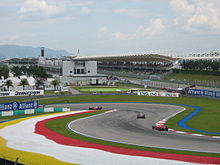
Popular sports in Malaysia include football, badminton, field hockey, bowls, tennis, squash, martial arts, horse riding, sailing, and skate boarding. Football is the most popular sport in Malaysia and Malaysia is studying the possibility of bidding as a joint host for 2034 FIFA World Cup. Badminton matches attract thousands of spectators, and since 1948 Malaysia has been one of three countries to hold the Thomas Cup. The Malaysian Lawn Bowls Federation was registered in 1997. Squash was brought to the country by members of the British army, with the first competition being held in 1939. The Squash Racquets Association of Malaysia was created on 25 June 1972. Malaysia has proposed a Southeast Asian football league. The men's national field hockey team ranked 15th in the world as of August 2010. The 3rd Hockey World Cup was hosted at Merdeka Stadium in Kuala Lumpur, as well as the 10th cup. The country also has its own Formula One track–the Sepang International Circuit. It runs for 310.408 kilometres (192.88 mi), and held its first Grand Prix in 1999.
The Federation of Malaya Olympic Council was formed in 1953, and received recognition by the IOC in 1954. It first participated in the 1956 Melbourne Olympic Games. The council was renamed the Olympic Council of Malaysia in 1964, and has participated in all but one Olympic games since its inception. The largest number of athletes ever sent to the Olympics was 57 to the 1972 Munich Olympic Games. Malaysian athletes have won a total of four Olympic medals, all of which are in badminton. The country has competed at the Commonwealth Games since 1950 as Malaya, and 1966 as Malaysia, and the games were hosted in Kuala Lumpur in 1998. Two styles of martial arts are being practiced in Malaysia; Silat and Malaysian kickboxing, called Tomoi.



